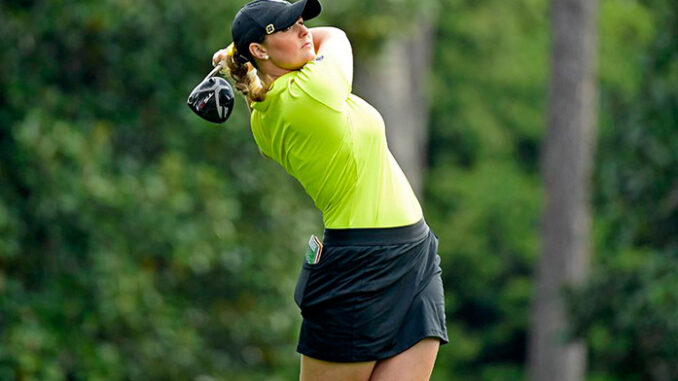
PHOENIX – At 8 a.m. on a cool Georgia Saturday morning, on one of the most iconic 18-hole courses in the world, two golfers drove their first tee shots in front of a large assembled gallery toward the wide fairway of Tea Olive, Augusta National’s opening hole. It may sound like a typical early April occurrence at Augusta, one that’s been happening since 1934.
It wasn’t.
This was the inaugural Augusta National Women’s Amateur, a three-day event that culminated at the historic and often infamous Augusta course that is home to the men’s Masters Tournament. It was the first time women have competed in an event there and among the participants were three members of the Arizona State women’s golf team.
“It was probably the most exciting event that I’ve played in my entire life and definitely my heartbeat was way higher than any other competition,” Sofia Anokhina said after she returned home. “It was something that I can’t really describe. I still look at it and it seems like a dream. It’s all a blur and there’s so many people and I’m just very excited.”
Anokhina and Olivia Mehaffey played in the final round on the famed course. Alessandra Fanali competed in the tournament’s first two rounds, staged at nearby Champions Retreat, but did not advance to Saturday’s competition. She did get to enjoy a practice round at Augusta. Two ASU recruits from Sweden – Linn Grant and Amanda Linner – who will join the Sun Devils in the fall, also participated.
Augusta has long been under scrutiny for its many years of a men-only policy. The club’s first two female members – former Secretary of State Condoleezza Rice and South Carolina businesswoman Darla Moore – weren’t admitted until 2012.

Anokhina shot an opening round of 77 and backed it up with a pressure filled 2-under par to survive the cut, enabling her to compete on one of the grandest individual stages in all of sports. The course that turned a Tiger loose. The course that now lifted the barrier and allowed women to compete at the home of the green jacket.
“I’m experiencing something that’s groundbreaking to my sport, to the future of the program, the players and other girls that grew up dreaming of being on the biggest stage in golf,” said ASU women’s golf coach Missy Farr-Kaye.
“I wanted them to be prepared and not be awestruck. It was really important to me that they understand. They sometimes forget that they’re as good as they are, and that they belong where they’re at.”
World Golf Hall of Famers Se Ri Pak, Lorena Ochoa, Nancy Lopez and Annika Sorenstam led off the final round, a nod to the traditional start of the Masters, in front of an eager gallery of spectators witnessing something new, something previously only dreamt of, something full of promise for the future of women’s golf.
And for Anokhina, the event was more than just a new representation of women’s golf, it was a new image for her native Russia, where she began golf at a later age than many that find themselves at this level of play. She started at age 12 as more of a hobby than anything and Russian winters being what they are, her actual on-course play was limited. She is now the first Russian, male or female, to compete at Augusta.
Anokhina, who plans to trade her amateur status for a professional card when she finishes at ASU, fired a 1-over through the aptly named Amen Corner, a nightmarish three holes of golf that has seen many a tournament won, or lost, around its many looming hazards. While many just brace for impact and hope to escape with a round still intact, Anokhina embraced the 11th, 12th and 13th holes of Augusta with passion.
“I actually loved it,” she said. “I think it was really fun and it was kind of my favorite part because of how many people there were. I think there were about a few thousand people just sitting in the stands and a few hundred walking.”
Anokhina enjoyed the stage.
“I’ll always look at it as if I’m an artist and I’m creating my piece of work” Anokhina said. “People get to just see how I see it, how I visualize it. … They share the emotion and their attitude towards your creation. That’s one of the coolest parts about golf.”
The tournament drew its share of criticism. Why, some wondered, was it scheduled in competition with the first women’s major tournament of the year? Why is there not a Women’s Masters? Why was the tournament spread across two courses and not just 54 holes at Augusta?
For Anokhina, the format was part of the reward.
“I think the fact that only the top 30 get to compete at Augusta is an amazing idea because you really fight hard. You fight so hard those two days, and regardless why you’re fighting, you know what you’re fighting for.”
However it was perceived, the event allowed the women to return home as newfound heroes in the sport and an inspiration to the next wave of young women that see golf as not only an avenue to professional sports but now one with one less barricade in its path.
Farr-Kaye may have said it best: “I think it was a little overwhelming at first. I’m not sure that anyone can really prepare for the first time, because this is the first time. For everything.”
